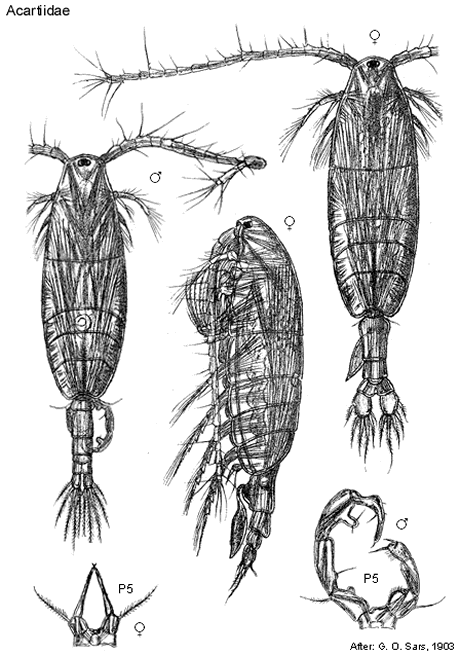 |
||||||
|
|
|
|
|
|
Calanoidea: FamiliesJ.M. Bradford-GrieveAcartiidae Sars, 1903 Description. Female. Rostrum with 2 filaments, or without filaments; rostral margin not extended. Cephalosome and pedigerous somite 1 separate; pedigerous somites 4 and 5 separate. Posterior corners of prosome in lateral view bluntly rounded, or with 1 acute point, or triangular or obtusely pointed; dorsal view symmetrical. Urosome with 3 free somites. Genital double-somite symmetrical in dorsal view; gonopores close together and partially covered by single cuticular flap, or separate and each covered by cuticular fold; with pair of seminal receptacles, or without seminal receptacles; with pair of copulatory pores that are completely covered by genital operculum, or without copulatory pores. Caudal rami symmetrical. Mouthparts. Antenna 1 with 17-22 free segments; ancestral segments X and XI separate. Antenna 2 exopod with 4 free segments; 8 setae; basis and endopod fused. Mandible basis with 1 seta, or with 2 setae; endopod terminal segment with 8-9 setae. Maxilla 1 basal exite seta present, or absent; exopod elongate relative to endopod. Maxilla 2 coxal epipodite seta absent. Maxilliped with coxa large, but basis and endopod reduced; coxal endite 2 with 2 setae, or with 3 setae. Legs. Leg 1 basis inner distal seta absent; outer seta present, or absent; endopod with 2 segments; exopod with 3 segments; exopod segment 1 with outer distal spine; exopod segment 3 with 4 inner setae. Leg 2 endopod with 2 segments; exopod with 3 segments; exopod segment 3 with 1 outer spine. Leg 3 basis outer distal spine absent. Legs 3 and 4 endopod with 2 segments; exopod with 3 segments; exopod segment 3 with 1 outer spine; exopod segment 3 with 5 inner setae. Legs 2-4 surfaces naked; exopods with outer edge spines completely fused to their segment; terminal spine with outer border serrated. Leg 5 present; very dissimilar from legs 2-4; coxa inner border without seta; usually uniramous, small, symmetrical, not natatory; coxae and intercoxal sclerite fused, or coxae, intercoxal sclerite and basis fused (Paracartia); basis with outer seta; exopod in form of spine with swollen base or elongate seta; small endopod present in Acartiella. Mode of life. Pelagic, in oceanic waters or in coastal waters. Depth distribution. Epipelagic (0-500 m). Generic composition. This family contains five genera: Acartia Dana, 1846; Acartiella Sewell, 1914; Paracartia T. Scott, 1894; Paralabidocera Wolfenden 1908; Pteriacartia Belmonte, 1998.
(Variant) Male (sexually dimorphic characters). Description. Male. Pedigerous somites 4 and 5 fused or partly fused. Posterior corners of prosome in lateral view bluntly rounded, or with 1 acute point. Caudal rami symmetrical, or asymmetrical. Mouthparts. Mouthparts well-developed. Antenna 1 geniculate on right. Maxilliped endopod segments 5 and 6 with outer setae normal. Legs. Right leg 5 uniramous; exopod usually 3-segmented, segments 1 and 2 often with inner processes, segment 3 opposed to process on segment 2 to form type of subchela. Left leg 5 uniramous; exopod 2-segmented (3-segmented in Paracartia africana), segment 2 with variously decorated tip.
Cite this publication as: 'Bradford-Grieve, J.M. (2002 onwards). Calanoida: families. Version 1: 2 October 2002. https://crustacea.net'. |
|
|
|
|
|
|
|
|
|
Copyright © Australian Museum, 2002 - 2003
Australian Museum website
